Health Ministry director-general Dr Noor Hisham Abdullah has attributed the recent Covid-19 surge in the Klang Valley to a spread of the extremely infectious Delta variant of the virus.
He also explained that the healthcare system was congested because each serious patient spent an average of two to three weeks in the hospital.
While the government scrambles for resources to save the Klang Valley, the top official said the only way to bring down cases was to conduct more tests and isolate low-risk positive cases.
That and hitting a 40 percent vaccination rate as soon as possible. The vaccination rate for the Klang Valley including KL, Putrajaya, and Selangor as of July 12 was 11.1 percent of the population.
“We imposed a strict movement control order on June 1. Within 10 days we flattened the curve from 9,020 cases to 5,000 and 4,000 cases.
“But now the cases have risen again. One of the factors for this rise is due to Covid-19 variants. The dominant variant now is the Delta variant... the Delta variant spreads very quickly,” he said during a press conference that was restricted to a handful of selected media only.
The Delta variant is known to have an infectivity rate (R0) of between five and eight. This means that for every 100 people infected, they are capable of infecting 800 more people.
Noor Hisham revealed that between July 2 and July 11, Malaysia sequenced 37 Covid-19 samples that turned out to be a variant of concern. Of these, 11 were of the previously dominant Beta variant, and 26 were of the Delta variant.
For the record, the Institute of Medical Research only manages to sequence a small portion of Malaysia's Covid-19 cases – about 30 samples out of tens of thousands of cases each week.
Long road to recovery
Meanwhile, Noor Hisham explained that hospitals in Selangor and Kuala Lumpur were clogged up because Category 4 (need oxygen support) and Category 5 (need ventilation) patients were taking a long time to recover.
This despite the fact that such cases accounted for only 15 percent of all infections.
“Our hospitals are crowded because Category 4 and Category 5 patients need longer-term treatment. For example, Category 4 patients need to be hospitalised for an average of 14 days while Category 5 patients need an average of 21 days.
“So although there aren’t many of these patients, a daily increase builds up and our hospitals become congested,” he said.

Earlier today, Prime Minister Muhyiddin Yassin announced yet another round of reinforcements for embattled Klang Valley hospitals.
Test more, vaccinate more
Noor Hisham said there was a need to increase testing to identify and isolate cases in the community and proposed the use of saliva-based self-tests which could be used at home.
“Some 80 percent of our positive cases are Category 1 (no symptoms) or Category 2 (mild symptoms).
“If we can isolate them, we will be able to reduce community infections,” he said.
There is also an urgent need to vaccinate 40 percent of the population as soon as possible.
Noor Hisham said while fully vaccinated people can still be infected with Covid-19, their chances of further spreading the disease to others would be halved.
Moreover, people who have been infected despite full vaccination (i.e. two weeks after receiving the second dose of a two-dose vaccine) tend to have less severe symptoms than unvaccinated people.
Hospital patients young and unvaccinated
More vaccinated people would mean less stress on the healthcare system, Noor Hisham said.
“We had three months to look at how developed countries (were implementing the vaccine rollout) and we saw how cases fell after they vaccinated 40 percent of their people.
“We believe we can do this if we ramp up our vaccination rate. If we can vaccinate 50,000 people in a day and maintain this for one to two months, we will be able to achieve 40 percent.
“And we will see a drop in cases in the hospitals as well as in the ICUs,” he said.
He pointed to a recent statistic where of the 2,341 fully vaccinated healthcare workers who contracted Covid-19, 99.8 percent (2,337) were either asymptomatic or had mild symptoms.
Just six healthcare workers required hospitalisation after they were identified as Category 3 (more serious symptoms) and Category 4 (need oxygen support) patients.
Noor Hisham also noted that the number of Covid-19 hospitalisations and ICU admissions involving people above 60 years old have fallen over the past six weeks, after most people in that age group have been vaccinated.
"The increase (in admissions) that we are seeing is from younger age groups that have yet to be vaccinated," he said. - Mkini



No comments:
Post a Comment
Note: Only a member of this blog may post a comment.